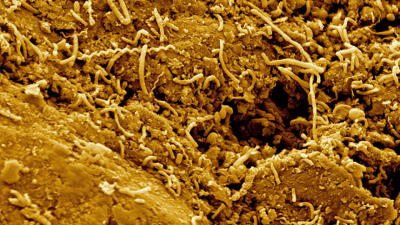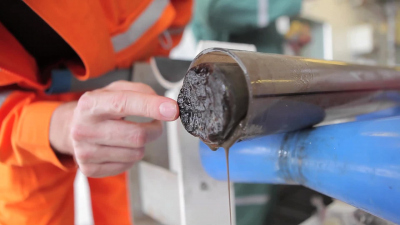Page path:
- Home
- Discover
- Media Releases
- Media Releases 2015
- 24-07-2015 Exploring the limits of life in the ...
Exploring the limits of life in the deep biosphere
The ocean’s seabed harbors one of the Earth’s largest ecosystems: the deep sub-seafloor biosphere. Microorganisms living here – bacteria and archaea – comprise at least as much biomass as all life in the overlying ocean. However, the lower boundary of this vast ecosystem has barely been documented so far. Earlier scientific ocean drilling expeditions have demonstrated the existence of microbial life down to a subseafloor depth of 1,922 meters. In order to explore the existence of life at even greater depths and to shed light on the limits of the deep biosphere, an international team of scientists undertook an expedition to the West Pacific Ocean onboard the Japanese deep-sea drilling vessel Chikyu in 2012.
Off the Japanese coast, co-chief scientists Kai-Uwe Hinrichs and Fumio Inagaki and a team of international colleagues recovered samples from down to 2,466 meters below the seafloor -- a new world-record in scientific ocean drilling. “We found cells in the bottom kilometer of the borehole. However, there were much fewer cells than we had expected based on extrapolations of observations from shallower boreholes around ocean margins.” Inagaki says. “These low concentrations suggest that we may have gotten close to the lower boundary of this particular sub-seafloor ecosystem. Despite this scarcity of cells, we have compelling evidence that microbes turn coal into methane at around two kilometers below seafloor”, Hinrichs adds.
This specialized microbial community lives in coal-bearing layers at temperatures around 40 to 60°C. The up to seven meter thick coalbeds formed about 20 millions years ago, when large quantities of terrestrial plant-derived organic matter were buried close to the shoreline. The resulting coastal sediments subsequently subsided due to tectonic processes, and then transformed into and buried within deep-sea sediments.
“Our analyses show that the microbial communities in the deep coal-bearing layers differ strongly from those found in the shallower sub-seafloor that typically harbors marine sediments”, Inagaki states and adds: “They rather resemble communities typically found in forest soils, which makes sense given that the substrates for coal formation originated in forest-like environments“. This suggests that some community members now buried at about two kilometers below the seafloor are remnants from communities that inhabited shallow coastal soils millions of years ago. “This finding raises the possibility that the initial community deposited with shallow sediments may be a more important factor in controlling the taxonomic composition of the deep subseafloor biosphere than the geochemical conditions in the sediment”, Hinrichs comments.
The fact that the deep biosphere has remained so enigmatic and full of unsolved research questions is partly due to the difficulty of obtaining pristine sub-seafloor samples for microbiological and biogeochemical research. It remains a major technological and scientific challenge to recover high-quality samples from these enormous depths. The samples examined for the Science study were taken in 2012 during Expedition 337 of the Integrated Ocean Drilling Program (today: International Ocean Discovery Program; IODP) with the Chikyu, the largest and most modern research vessel worldwide, 80 km off the coast of the Shimokita Peninsula, Japan.
Publication:
Exploring deep microbial life in coal-bearing sediment down to ~2.5 km below the ocean floor
Fumio Inagaki, Kai-Uwe Hinrichs und 44 weitere Autoren
Science magazine, July 24th 2015
Further Information / Interviews / Images:
Jana Stone
MARUM Public Relations
Phone: 0049 - 421 218 65541
E-mail: [Bitte aktivieren Sie Javascript]
Off the Japanese coast, co-chief scientists Kai-Uwe Hinrichs and Fumio Inagaki and a team of international colleagues recovered samples from down to 2,466 meters below the seafloor -- a new world-record in scientific ocean drilling. “We found cells in the bottom kilometer of the borehole. However, there were much fewer cells than we had expected based on extrapolations of observations from shallower boreholes around ocean margins.” Inagaki says. “These low concentrations suggest that we may have gotten close to the lower boundary of this particular sub-seafloor ecosystem. Despite this scarcity of cells, we have compelling evidence that microbes turn coal into methane at around two kilometers below seafloor”, Hinrichs adds.
This specialized microbial community lives in coal-bearing layers at temperatures around 40 to 60°C. The up to seven meter thick coalbeds formed about 20 millions years ago, when large quantities of terrestrial plant-derived organic matter were buried close to the shoreline. The resulting coastal sediments subsequently subsided due to tectonic processes, and then transformed into and buried within deep-sea sediments.
“Our analyses show that the microbial communities in the deep coal-bearing layers differ strongly from those found in the shallower sub-seafloor that typically harbors marine sediments”, Inagaki states and adds: “They rather resemble communities typically found in forest soils, which makes sense given that the substrates for coal formation originated in forest-like environments“. This suggests that some community members now buried at about two kilometers below the seafloor are remnants from communities that inhabited shallow coastal soils millions of years ago. “This finding raises the possibility that the initial community deposited with shallow sediments may be a more important factor in controlling the taxonomic composition of the deep subseafloor biosphere than the geochemical conditions in the sediment”, Hinrichs comments.
The fact that the deep biosphere has remained so enigmatic and full of unsolved research questions is partly due to the difficulty of obtaining pristine sub-seafloor samples for microbiological and biogeochemical research. It remains a major technological and scientific challenge to recover high-quality samples from these enormous depths. The samples examined for the Science study were taken in 2012 during Expedition 337 of the Integrated Ocean Drilling Program (today: International Ocean Discovery Program; IODP) with the Chikyu, the largest and most modern research vessel worldwide, 80 km off the coast of the Shimokita Peninsula, Japan.
Publication:
Exploring deep microbial life in coal-bearing sediment down to ~2.5 km below the ocean floor
Fumio Inagaki, Kai-Uwe Hinrichs und 44 weitere Autoren
Science magazine, July 24th 2015
Further Information / Interviews / Images:
Jana Stone
MARUM Public Relations
Phone: 0049 - 421 218 65541
E-mail: [Bitte aktivieren Sie Javascript]
Black coalbed layers in one of the cores of the IODP expedition.
Photo: Luc Riolon, MARUM/IODP
Fumio Inagaki (left) and Kai-Uwe Hinrichs are satisfied after IODP Expedition 337 has just surpassed the previous world record in scientific ocean drilling of 2,111 meters below seaflorr.
Photo: Luc Riolon, MARUM/IODP





